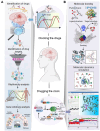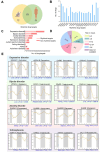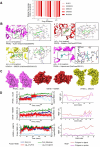Integrated bioinformatics and interaction analysis to advance chronotherapies for mental disorders
- PMID: 39703389
- PMCID: PMC11655208
- DOI: 10.3389/fphar.2024.1444342
Integrated bioinformatics and interaction analysis to advance chronotherapies for mental disorders
Abstract
Introduction: Robust connections have been identified between the pathophysiology of mental disorders and the functioning of the circadian system. The overarching objective of this study was to investigate the potential for circadian rhythms to be leveraged for therapeutics in mental disorders.
Methods: We considered two approaches to chronotherapy-optimal timing of existing medications ("clocking the drugs") and redressing circadian abnormalities with small molecules ("drugging the clock"). We assessed whether circadian rhythm-modulating compounds can interact with the prominent drug targets of mental disorders utilizing computational tools like molecular docking and molecular dynamics simulation analysis.
Results: Firstly, an analysis of transcript-level rhythmic patterns in recognized drug targets for mental disorders found that 24-hour rhythmic patterns were measurable in 54.4% of targets in mice and 35.2% in humans. We also identified several drug receptors exhibiting 24-hour rhythmicity involved in critical physiological pathways for neural signaling and communication, such as neuroactive ligand-receptor interaction, calcium signaling pathway, cAMP signaling pathway, and dopaminergic and cholinergic synapses. These findings advocate that further research into the timing of drug administration in mental disorders is urgently required. We observed that many pharmacological modulators of mammalian circadian rhythms, including KL001, SR8278, SR9009, Nobiletin, and MLN4924, exhibit stable binding with psychotropic drug targets.
Discussion: These findings suggest that circadian clock-modulating pharmacologically active small molecules could be investigated further for repurposing in the treatment of mood disorders. In summary, the present analyses indicate the potential of chronotherapeutic approaches to mental disorder pharmacotherapy and specify the need for future circadian rhythm-oriented clinical research.
Keywords: chronotherapeutics; circadian rhythm; interaction analysis; mental disorders; molecular dynamics simulation.
Copyright © 2024 Bhatnagar, Raj, Das, Kannihali, Rajakumara, Murray and Ray.
Conflict of interest statement
The authors declare that the research was conducted in the absence of any commercial or financial relationships that could be construed as a potential conflict of interest.
Figures





References
Grants and funding
LinkOut - more resources
Full Text Sources

